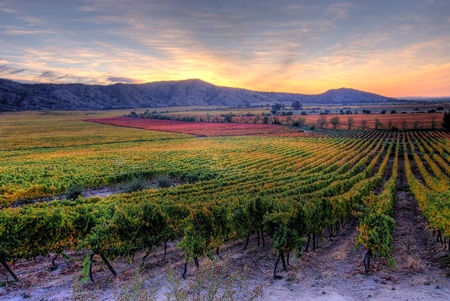I know I’ve said it before but in case you weren’t listening the first time, I shall say it again. Some of the best-value table wines in the world come from Chile. Yes, Chile. That’s the long, narrow country on the Pacific coast of South America. If you normally look for wines around the Bt. 390 price tag, there’s a terrific range of Chilean wines available.
Most Chilean wines come from the Central Valley (or Valle Central if you prefer some local colour). It’s one of the most important and biggest wine-producing areas in South America in terms of volume. With cool, rainy winters and warm summers it has high daytime temperatures moderated by cool nights. It’s ideal for growing grapes and a wide variety of wine styles can be found there.
The wines this week come from the Garces Silva family, which has been involved in wine-growing for three generations. The Las Condes range is produced from hand-picked grapes and distributed by Carolina Wine Brands, a well-known winery in Chile and around the world. If you decide to try these two wines you might also look out for the Las Condes Carmenere made from Chile’s own signature grape. Oh, and in case you’re wondering, Las Condes is a popular and trendy neighbourhood of Santiago, Chile’s capital city.
“Las Condes” Sauvignon Blanc 2011 (white), Chile (Villa, Bt. 395)
Just look at this! It’s a very pale gold wine with hints of green in the glass and a delicate floral aroma with of sweet, ripe gooseberries, a hint of grassiness, and dry herbs. Actually, you might think you can pick up the smell of pineapples, but actually, they’re gooseberries. Definitely gooseberries. Even the dogs agreed.
 La Rinconada vineyard, source of “Las Condes” wines.
La Rinconada vineyard, source of “Las Condes” wines.
The wine has a gorgeously soft mouth-feel with loads of fruit well forward (gooseberries, surprisingly), but there are hints of passion fruit and a faint taste of apples. I thought I could pick up a suggestion of mandarin oranges too. Actually, when you get complex flavours like this coming through, it is a sign of a really well-made wine.
It’s a very soft, medium-bodied easy drinker; well-balanced, fairly dry with very mild acidity and a lingering fruity finish with a final reminder of citrus. I loved it. The long finish, incidentally, is another sign of a well-made wine.
At only 12% alcohol content, this fresh young wine is a terrific drink on its own, but it would pair well with fish, light chicken dishes or goat cheese. Recently, I read that Sauvignon Blanc is one of the few wines that work well with sushi. Give it a try.
“Las Condes” Merlot 2010 (red), Chile (Villa, Bt. 395)
The Merlot grape has strong historical ties with both Bordeaux but of course it’s now planted all over the world. This one is a bright ruby-red and looks very inviting. Swirl it around in the glass and those attractive “legs” will appear. This, of course is why you need large wine glasses so that you can fill them about one third full, thus allowing space for the ritual (and essential) swirling. The aromas of red fruit, cherries and strawberries will greet you when you stick your nose into the glass. You’ll probably pick up a dash of vanilla and plums in the background, with possibly a hint of dry herbs and cinnamon. By the way, this is yet another reason for a large wine glass – big enough to get your nose inside. You see, a few dainty sniffs from somewhere above the glass is just not enough. Get your snout right in there and go for it like a bloodhound.
The fruit is well-forward and the wine has a lovely smooth mouth-feel. It’s completely dry, fairly light-bodied and well-balanced, with very soft tannins and a satisfying long dry finish with just a hint of citrus.
Drink this on your own if you want (it’s just over 12% alcohol content) but it would make a good partner for light meals, red meats or pasta. This is lovely easy-drinker that I shall buy again, but if it’s all gone when I get to the shop, I shall know who to blame.




